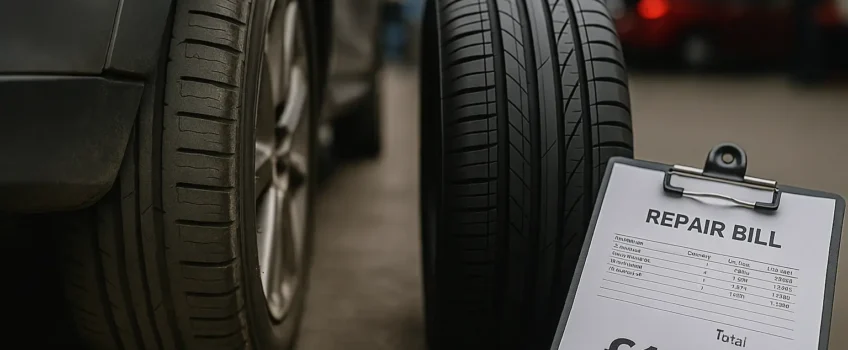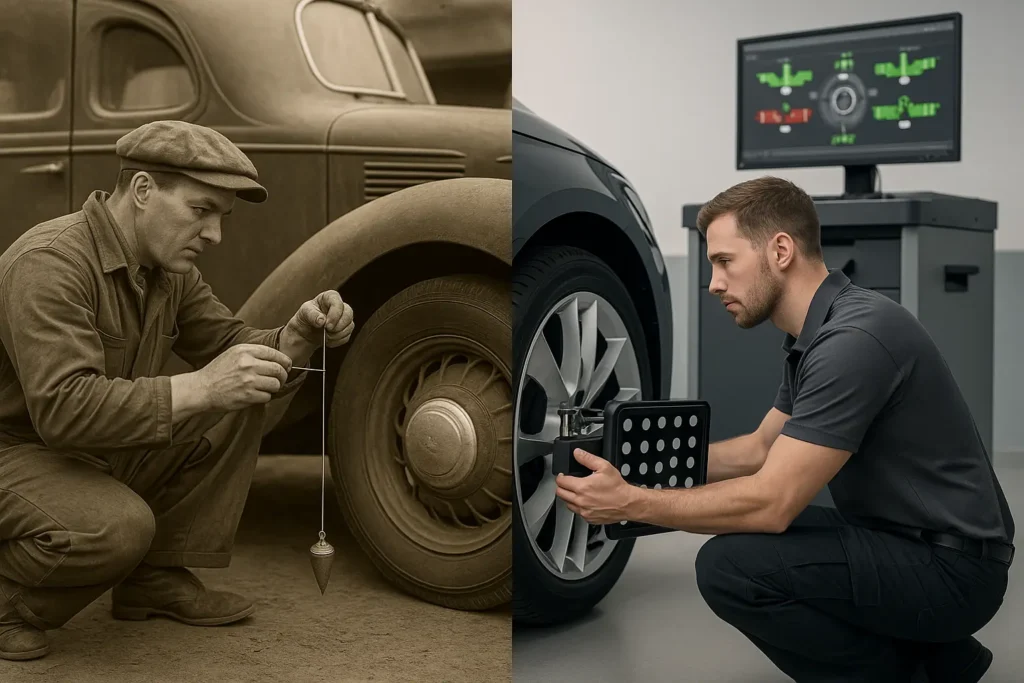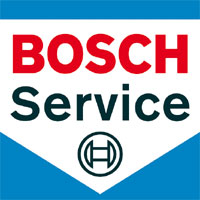
Why Wheel Alignment Matters More Than You Think
Wheel alignment refers to the precise adjustment of your car’s suspension system—the part that connects the vehicle to its wheels. It’s not actually about adjusting the tyres or wheels themselves, but rather the angles they sit at when your car is on the road.
When your alignment is off, you may not even notice at first. However, it can cause uneven tyre wear, poor handling, and lower fuel efficiency over time. More importantly, it can compromise your car’s safety by reducing road grip and steering control.
What are the Most Common Signs a Car May Need a Wheel Alignment?
Not sure whether your wheels need aligning? Look out for these common symptoms:
- Your car pulls to one side while driving
- The steering wheel isn’t centred when driving straight
- You notice uneven or rapid tyre wear
- Steering feels loose or unresponsive
- You hear strange noises when turning
If any of these sound familiar, we recommend booking an alignment check or alignment service.
Can Bad Alignment Cause Poor Fuel Economy?
Wheel alignment doesn’t just affect how your car drives, it also impacts how much you spend at the pump. Misaligned wheels create drag and increase rolling resistance, meaning your engine has to work harder to move the car forward.
This added strain can decrease your miles per gallon, especially on longer journeys. So if you’re trying to make your tank go further (and who isn’t, with today’s prices?), keeping your wheels aligned is a simple way to improve fuel economy.
The Hidden Cost of Ignoring Your Alignment

It’s tempting to ignore small issues, especially if your car still drives “mostly fine.” But like most car problems, misalignment tends to snowball and before you know, something more serious and expensive goes wrong.
Left unchecked, bad wheel alignment can lead to:
- Early tyre replacement (a set of tyres isn’t cheap)
- Extra wear on suspension components
- A higher chance of MOT failure
- Unsafe handling in wet or emergency conditions
Think of it this way: a simple alignment check could save you hundreds in premature repairs. So, to ensure your own safety and your car’s performance, check your alignment at least once a year. Remember, even hitting the pavement or a speed bump a little too fast can affect your wheel positions or angles.
How Often Should You Get a Wheel Alignment Check?
There’s no one-size-fits-all rule, but as a general guideline, here is when you should check your alignment:
- Every 1-2 years or 12,000–15,000 miles
- After hitting a large pothole or kerb
- If you’ve had suspension or steering repairs
- Whenever you replace your tyres
For frequent drivers or those who drive on uneven roads, you might benefit from more frequent checks.
Why Summer Makes Wheel Alignment Even More Important
Hot weather, long journeys, and heavier loads all put more strain on your vehicle’s suspension. Add in potholes from winter damage and kerb bumps while parking at the beach, and you’ve got a recipe for misaligned wheels.
Here’s why alignment should be part of your summer car checklist:
- Tyre pressure changes in the heat can exacerbate misalignment issues.
- Longer journeys mean more wear and tear, making accurate alignment essential.
- Hot tarmac softens rubber, so uneven wear becomes more likely on poorly aligned wheels.
It’s Not Just About Alignment—Other Services to Keep You Safe
A proper car service involves more than wheel alignment. At Elite Garages, we help keep your vehicle running smoothly with a wide range of services, including:
- Cambelt replacement services to avoid engine failure
- ADAS calibration for vehicles with advanced safety systems
- Car diagnostics to spot and fix issues early
- Tyre checks and replacements for optimal grip and safety
All of these car services help prolong the life of your car and keep your driving experience stress-free. Don’t forget, we service most car makes and models as per the manufacturer’s specification. You will also receive dealership quality service at a better price.
Is There a Difference Between Alignment and Wheel Tracking?
Think of wheel tracking as the simpler, surface-level check for your wheels. It’s a term you might still hear in some garages, though it’s not as common among professional technicians. At its core, wheel tracking refers to making sure your wheels are parallel and correctly aligned in relation to one another and the direction your car is travelling. It’s a more basic version of wheel alignment—focused on keeping things straight and steady.
Wheel alignment is a more in-depth process that examines how your wheels interact with your car’s suspension system. It involves fine-tuning several critical angles: camber (how much the tyres tilt in or out when viewed from the front), toe (whether the tyres point slightly inward or outward), and caster (the steering pivot angle, which affects balance and stability). Proper alignment ensures your tyres have full, even contact with the road—helping to prevent uneven wear and improve overall handling.
Why the Confusion?
The confusion arises because both terms relate to how your wheels sit and behave on the road. While “wheel tracking” is often used in everyday conversations, “wheel alignment” is the more precise, technical term used by specialists. Ultimately, both aim for the same outcome: safer handling, improved tyre life, and better vehicle performance through proper wheel positioning.
A Brief History of Wheel Alignment
Here’s a curveball you probably didn’t expect. Did you know that wheel alignment has roots stretching back over a century? In the early 1900s (1920-1930), as motor vehicles began to replace horse-drawn carriages, mechanics realised that cars needed precision steering geometry to avoid uneven tyre wear and improve handling.

The earliest alignment systems were manual and used string, rulers, and spirit levels. After WWII, garages upgraded to optical machines that used light and mirrors for more accurate wheel checks. By the 1980s, digital systems with sensors and software improved speed and precision.
Fast forward to today, and alignment is done with laser-guided equipment that measures down to fractions of a millimetre, just like the tech we use at Elite Garages. Even in modern electric and hybrid vehicles, precise wheel alignment remains essential to maintain battery efficiency and reduce wear.
Where Can I Get Wheel Alignment Near Me?
Wherever you’re based in the South of England, there’s likely an Elite Garages branch nearby that offers professional, precise wheel alignment services. Here’s a list of our locations, each ready to help with expert tracking and alignment to keep your car safe and smooth on the road:
- Wheel Alignment Bournemouth
- Brighton Wheel Alignment Services
- Canterbury Wheel Alignment Centre
- Caterham Wheel Alignment & Balancing
- Deal (Walmer) Tyre & Wheel Tracking Experts
- Denmead Wheel Alignment Service Centre
- Dorchester Wheel Alignment Services
- Eastbourne Car Alignment Services
- Fareham Wheel Alignment Garage
- Haywards Heath Wheel Tracking & Suspension
- Horsham Precision Wheel Alignment
- Maidstone Vehicle Alignment Specialists
- Newport Tyre Tracking & Wheel Alignment
- Portsmouth Wheel Alignment & Tyre Fitment
- Pulborough Wheel Alignment Checks
- Salisbury Wheel Alignment & Tyre Fitment Centre
- Shaftesbury Alignment & Tracking Services
- Southampton Alignment Centre
- Strood Wheel Alignment Service Centre
Final Thoughts on Professional Wheel Alignment Services
Wheel alignment isn’t just for when something feels wrong. It’s a preventative service that saves you money, fuel, and stress, especially when your summer depends on safe, smooth driving. If it’s been a while since your last check, make it part of your summer car maintenance routine. If you have any questions or would like to make a booking, please contact your nearest branch.
FAQS
Click the + to read any answer or visit our most FAQ page to review the most frequently asked questions across all our Elite Locations.
If you click on a ‘Category’ or ‘Tag’ link, the page will ‘refresh’ and reload the page showing the top of the page first, you’ll then just need to scroll down to the FAQ section to see the results for the Category or Tag you selected.
Yes, it is possible to perform a two-wheel alignment, also known as a front-end alignment where technicians perform the service on only the front wheels. This may include a camber, toe, and caster adjustment.
Yes, it is recommended to get a four-wheel alignment when you fit new tyres. Even brand new tyres can be affected by improper wheel alignment, which can lead to uneven tyre wear, increased fuel consumption and poor handling.
To determine whether you need a two-wheel or four-wheel alignment service, you first need to consider your type of vehicle and the symptoms you are experiencing. If you need assistance, please contact your nearest Elite Garages branch for more information or you can book your wheel alignment online!
Put simply, two-wheel alignment is a procedure that corrects the positioning of your front wheels, while four-wheel alignment adjusts all four. Generally speaking, it’s not necessary to perform the latter on large SUVs or trucks with solid rear axles unless an accident has occurred and caused misalignment in its frame which translates into “dog tracking”.
About Us
Opening Times
Saturday : 8:30–4:00
Sunday : closed
More Information
Contact UsCustomer Information Pack
Check MOT Due Date
Free MOT reminder
Careers
Legal Information
Recent Posts
- Why Short Winter Journeys Cause So Many Common Car Problems
- Why Car Problems Happen More Often in January (And What Drivers Miss)
- Why the Right Car Service Garage Matters: Advice Drivers Trusted Most in 2025
- Christmas Guide to Winter Car Checks: From All of Us at Elite Garages
- Want to Prevent Exhaust Damage and Reduce Emissions?


